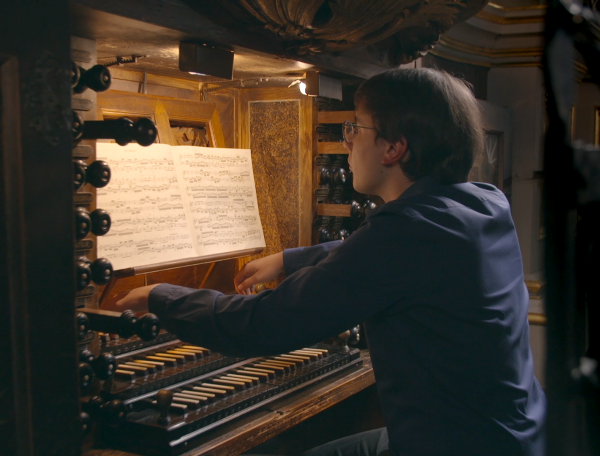

Duet no. 3 in G major
BWV 804 performed by Leo van Doeselaar
Freiberger Dom Sankt Marien, Freiberg, Germany
Behind the music
The music speaks
An organ duet in the style of an aria
As the function and meaning of the four duets in the third part of the Clavier-Übung are far from clear, much has been written about them. If there is any specific meaning behind the duets at all, then in the case of this third one it is a sense of jubilant happiness. The dancy 12/8 time and the sparkling festoons of notes leave little room for another interpretation. Furthermore, this duet has the fewest harmonic peregrinations and the least complicated composition techniques of the four duets. All in all, this makes BWV 804 the clearest point in the third part of the Clavier-Übung.
Although this duet is just as instrumental as the other three, it is the only one that is reminiscent of a virtuoso aria from a cantata – maybe due to its cheerful character. To the opening motif, you could easily sing the words “freuet euch”, or something similar. See, for example, the tenor aria from cantata BWV 40. This, too, is in a lively 12/8 time, and the words “Christenkinder, freuet euch” are set to music with the same atmosphere and musical idiom as this duet.
Once again, we see that Bach had an arsenal of musical precision weapons, with which he could express a wide range of emotions – even without text and clear meaning. In the end, the clearest language in these duets is the music itself.
Clavier-Übung
In Leipzig, between 1731 and 1741, Bach published four parts of Clavier-Übung, a title used previously by Johann Kuhnau, his predecessor as cantor at the Thomasschule, for similar collections of works for organ and harpsichord. The compositions are very varied in nature and, although the title suggests otherwise, were difficult to play. Bach addresses all the styles, genres and techniques for harpsichord and organ that were prevalent at the time, but then in the superior form to which only he had the patent.
Clavier-Übung I (1731) contains the six partitas, BWV 825-830; Clavier-Übung II (1735) the Concerto nach italienischen Gusto, BWV 971 and the Ouverture nach französischer Art, BWV 831; and Clavier-Übung IV (1741) the Goldberg Variations, BWV 988. The largest part, Clavier-Übung III (1739), is the only one devoted to organ, containing mostly chorale arrangements, or organ preludes based on Lutheran hymns. Bach made two versions of each chorale: one for great organ and one for a smaller type of organ. Most of the chorales refer to the six parts of the catechism. It is unclear whether Bach also played them during the services, or whether he developed his musical ideas in them for his own use, with no intention of performing them in public.
- BWV
- 804
- Title
- Duet no. 3 in G major
- Instrument
- organ
- Genre
- organ works
- Serie
- Clavier-Übung III
- Year
- 1739
- City
- Leipzig
With support from
Extra videos
Vocal texts
Original
Translation
Credits
-
- Release date
- 3 August 2023
-
- Recording date
- 16 September 2020
-
- Location
- Freiberger Dom Sankt Marien, Freiberg, Germany
-
- Organist
- Leo van Doeselaar
-
- Organ
- Gottfried Silbermann, 1711-1714
-
- Director and editor
- Robin van Erven Dorens
-
- Music recording
- Guido Tichelman, Bastiaan Kuijt
-
- Music edit and mix
- Guido Tichelman
-
- Camera
- Robin van Erven Dorens, Onno van der Wal
-
- Lights
- Ernst-Jan Thieme
-
- Assistant music recording
- Marloes Biermans
-
- Interview
- Robin van Erven Dorens, Marloes Biermans
-
- Producer
- Jessie Verbrugh
-
- With support from
- MWH4impact
Discover
Help us to complete All of Bach
There are still many recordings to be made before the whole of Bach’s oeuvre is online. And we can’t complete the task without the financial support of our patrons. Please help us to complete the musical heritage of Bach, by supporting us with a donation!

